
Jan 6, 2022Welcome water news seen for California farmers and ranchers
After two consecutive years of drought, the state Department of Water Resources conducted the season’s first manual survey of the snowpack Dec. 30 and found a promising result – deep snow totaling 160% of average for the time of year.
State Climatologist Michael Anderson said storms in December that dumped several feet of snow in the Sierra Nevada and brought much-needed precipitation were “a great start to the water year.”
“December came in exactly the way we would’ve wanted it to,” he said, “just a parade of storms building a good start to the snowpack and getting water on the ground.”
Heading into what typically is the season’s key period for precipitation, the measurement was welcome news for California farmers and ranchers, who faced severe water cutbacks in 2021 due to historic drought conditions. The early series of snow and rainstorms left some hopeful for more plentiful water supplies for 2022.
“We just got quite a bit of snow here. This is the Christmas gift everybody wanted in February of last year, but we’re thrilled to have it,” said Siskiyou County farmer Scott Seus of Tulelake. “It gives us some potential for a reasonable water year.”
He added, “We’ve still got a long way to go.”
The season’s first snow survey measures water content in the snowpack, which supplies a third of the state’s water supply. The measurement was recorded at the Phillips Station snow course, one of more than 260 snow courses across the Sierra Nevada that DWR manually or electronically measures each winter and early spring.
DWR recorded 78.5 inches of snow depth and a snow water equivalent of 20 inches, which is 202% of average for the location. The snow water equivalent measures the amount of water contained in the snowpack and helps forecast the amount of water that will melt and drain into state reservoirs.
Lake Shasta north of Redding, the largest reservoir in the federal Central Valley Project, now stands at about 50% of average storage. Lake Oroville in Butte County, the principal State Water Project reservoir, has about 74% of its historical average for the date, while San Luis Reservoir, a critical south-of-delta holding facility for both the SWP and CVP, remains at 49% of average.
California received a welcome storm in October, followed by dry conditions during November. Mother Nature surprised the state in December, with a high-pressure system over the Pacific Ocean that brought a parade of cold, atmospheric river storms. The series of systems dropped snow in the high elevations and led to white-out conditions that closed major highways. Cold temperatures also brought frost concerns to the valley.
“California has the most variable year-to-year climate in the U.S. Within a year, we can go from really wet to really dry,” Anderson said. “We’ve already seen that this water year, with that late-October storm that was just huge in Northern California mostly, but then November went dry.”
Back-to-back drought years led to emergency curtailment orders last year for some watersheds and little to zero water allocations for water districts. Expectations were that California would face another dry year, based on a La Niña atmospheric phenomenon in the Pacific Ocean, which generally signals drier, warmer conditions.
This still could be the result, according to Anderson, who said the climate outlook remains a source of caution.
“Computer models are suggesting that the high pressure is going to return back to the Eastern Pacific, which tends to dry us out,” Anderson said. “The question becomes: Does it move back in there and stay? That would not be the preferred outcome because we’d go dry again. It can waffle back and forth.”
Chris Scheuring, California Farm Bureau senior counsel, said, “We know that California has wildly variable precipitation. It will come all at once and then go dry for months at a time. That’s the hydrology and the climatology of California, but at the same time, it’s certainly a good time to stop and pause and be grateful for what we’ve had so far and to hope that it continues.”
For Seus and other Klamath Basin farmers who rely on federal Central Valley Project water from Upper Klamath Lake, they are hoping for the best and planning for the worst. Last year, they learned late in the season that they would receive a zero-water allocation, and in 2020, they received 144,000 acre-feet.
“It was a rough and bumpy road,” Seus said of the 2020 allocation. “None of it was predictable, and you had to fight for every drop that you got.”
Snow began falling on Christmas night at Klamath Falls, which received 16 to 20 inches of snow. Late-December snowstorms helped increase the Klamath Basin’s snowpack to 123% of normal, Seus said.
“Probably after the 1st of January, conversations will start getting real about what’s upcoming. It is a whole bunch of speculation up until the point where we get to March and April when we actually start to see numbers from the government,” Seus said.
Klamath Water Users Association legal counselors Somach Simmons & Dunn said in a statement “the historic severity of this past summer’s drought has alleviated with recent winter rain and snow in the early ’21-’22 winter season.”
However, the statement added, “water managers continue to plan on acutely challenging conditions to persist through 2022.”
As uncertainty persists over whether snowpack and ensuing water runoff will be sufficient to replenish reservoirs and supply agriculture through hot summer months, the DWR plans to continue to monitor snowpack, precipitation and water storage levels for another three or four months.
– Christine Souza, California Farm Bureau Federation
The state Department of Water Resources survey team trudges through snow to conduct the first 2022 survey of the snowpack at Phillips Station in the Sierra Nevada. Photo: California Department of Water Resources







